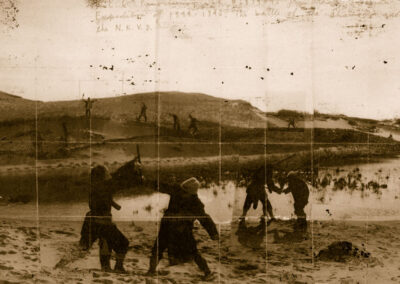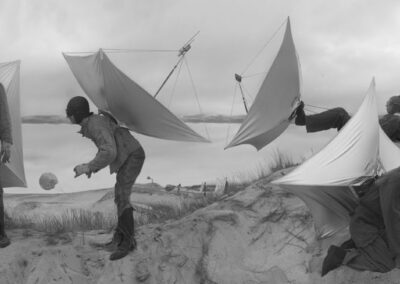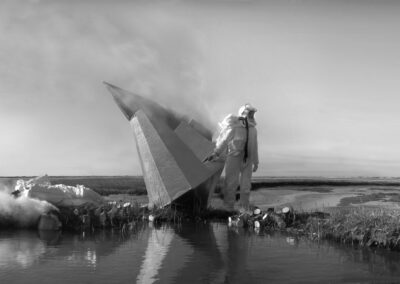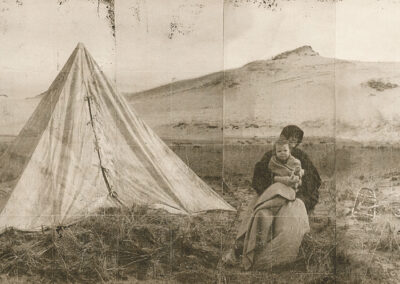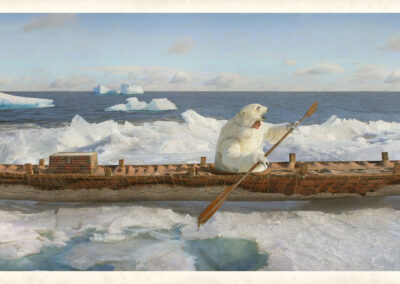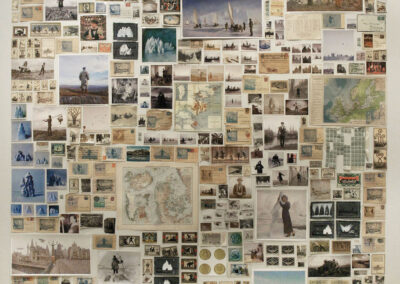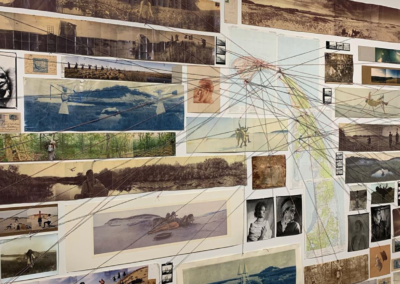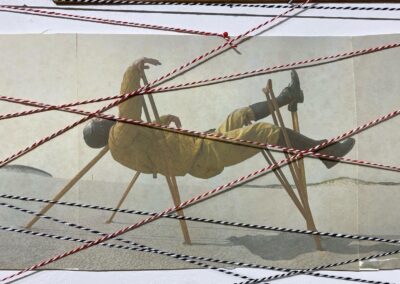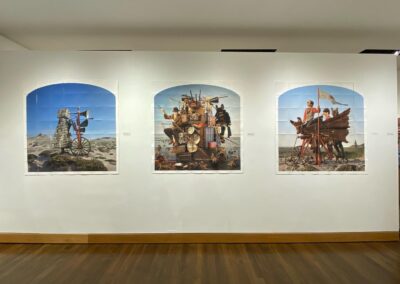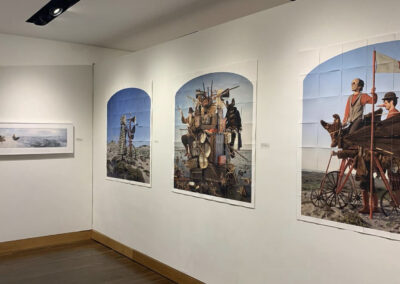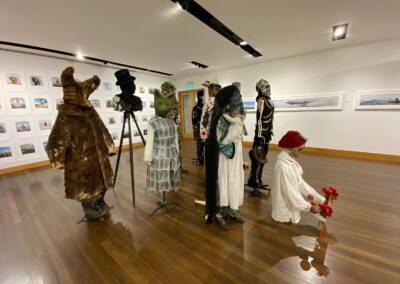
Theatre of Operations:
Kahn & Selesnick on the Outer Cape 1989-2019
at The Provincetown Art Association and Museum
Provincetown Art Association and Museum (PAAM) is thrilled to present an exhibition of work by Kahn and Selesnick, curated by Mark Adams and Maura Coughlin, September 18-January 24, 2021. PAAM is currently open to the public Wednesday-Sunday from 11am-5pm for five 1-hour long time slots/day. Reservations are strongly encouraged, and can be made at www.paam.org/tickets. Visitors are encouraged to visit the PAAM website in advance to confirm hours.
ARTWORKS IN THE EXHIBITION/ PART ONE:
Nicholas Kahn and Richard Selesnick are a collaborative artist team who have been working together since meeting at Washington University in St. Louis in the early 1980s. Initially, this involved assisting each other in their own separate but similar projects before they officially teamed up under the Kahn & Selesnick moniker in 1988. Like many other collaborative artist teams and collectives, their practice revolves around world-building and narrative, and spans forays into many different media. After starting off working primarily in photography and printmaking while at art school, they expanded into painting, sculpture, and text after moving to Cape Cod in 1988 to start their collaboration in earnest. These early works included installation elements such as portraits painted on plaster panels; heads made of bread, honey, and wax; ritual raviolis made of terra cotta; and a beehive that played absurdist agricultural folk songs from a blackened antler. This phase of their career culminated in the building of a wooden chapel to contain these absurdist/devotional objects entitled “The Rood-loft of the Drunken Beekeeper”.
During this portion of their career, the landscape of Cape Cod would feature heavily in their work, the artists making frequent forays into the marshes and dunes to photograph costumed characters in situ as source material for their painted portraits. Recognizing that this element of interacting the landscape directly was in fact the most vital part of their practice, Kahn & Selesnick decided to prioritize photography in their work, allowing the viewer the vicarious pleasure of accompanying the two artists on their quixotic adventures both on Cape Cod and in other locations as diverse as the deserts of the western United States and the upland bogs of Scotland’s Isle of Skye. Even before embarking on their photographic career, the artists had been attracted to the panoramic format as a means of immersing the viewer in the drawn or painted landscape, making the transition to panoramic photographs a natural one. Early attempts made heavy use of the color Xerox machine as a tool for producing sepia images that could be collaged together from many different snapshots taken in the field, then folded and aged to produce seemingly real false histories documenting the artist’s interest in shamanism, trance, and alternative realities. These were presented to the viewer as factual evidence and were frequently mixed with actual archival materials and objects. As events in the real world became ever more outlandish and alarming, Kahn & Selesnick’s projects grew more and more absurd, including Scotlandfuturebog, images of Scottish bog dwellers after an imagined but vague apocalyptic event; the Apollo Prophecies, about a lost Edwardian expedition to the moon; and Eisbergfreistadt, a series about an iceberg running aground in the German city of Lübeck during the height of the hyperinflation of the 1920s. As credulity stretched to braking point, the artists eventually abandoned their museological methodology to focus on creating full-on dadaist actions in nature to express their concern with climate change and environmental degradation. To this end they created an absurdist theater troupe called the Truppe Fledermaus, and an ongoing series of performances entitled “The Carnival at the End of the World”.
PART TWO:
Works undertaken for this project include a sequence of photographs documenting the Truppe’s performances, enacted for no audiences in remote locations; posters advertising these non-performances; suites of costumes for characters appearing in these non-existent events, including bats, greenmen, wildlings, and hobby horses; and written accounts of the Truppe’s exploits that are equal parts truth and lies.
Using the projects mentioned above, this upcoming exhibition at PAAM aims to explore the artist’s use of the Outer Cape as a backdrop for this diverse set of projects, and how this singular landscape has both informed and transformed themes and currents that run through the artist’s work. In certain respects, Kahn & Selesnick may be viewed essentially as filmmakers whose final output includes all the elements of filmmaking other than the actual film itself. In this regard, the Outer Cape, which can almost be seen as a location that is both no place and every place, has functioned as a kind of studio backlot for the artist’s fictive adventures, doubling for settings as diverse as the Martian plains to the stunted boreal forests of Siberia. However, during the artist’s interactions with this landscape, it moved from being a landscape-everyman to having a starring role, as the artists became obsessed with the changes they saw occurring on their various expeditions into the dunes and marshes. The Outer Cape is a laboratory for both the rewilded post-industrial landscape, and for the ravages caused by climate change induced storms and flooding, themes that have gradually become paramount in the artist’s work. An immersive installation, including panoramic photographs, wall installations, maps, text, costumes and props, documents the artist’s evolving reaction to extraordinary place that is the Outer Cape, transforming its terrain into a theatre of memory that is at once deeply personal and reflective of the powerful forces that are changing and consuming this unique landscape.
Nicholas Kahn lives in Ghent NY, and Richard Selesnick in Barrytown NY. Kahn & Selesnick have exhibited extensively throughout the US, Europe, Australia and beyond and exhibit regularly at the Provincetown’s Schoolhouse Gallery, where they are also represented.
Provincetown Art Association and Museum was established in 1914 by a group of artists and townspeople to build a permanent collection of works by artists of outer Cape Cod, and to exhibit art that would allow for unification within the community. Through a comprehensive schedule of exhibitions of local and national significance and educational outreach, PAAM provides the public access to art, artists, and the creative process. The PAAM Membership is a vibrant community of over 1,800 individuals. Whether you’re an artist or you simply love the arts, a PAAM Membership opens the door to programs and events that enrich and inspire.
Located at 460 Commercial Street, PAAM is open by reservation Wednesday-Sunday with 5 available time slots: 11am-12pm; 12:15-1:15pm; 1:30-2:30pm; 2:45-3:45pm; and 4-5pm. The first time slot is reserved for guests who are 60-years and older or in a high-risk group.
Tickets are available for online booking, visit www.paam.org/tickets to reserve your visit today. You may also reserve by phone, please call 508-487-1750 during our ticketing hours (Tuesday-Saturday from 10am-4pm) to make your reservation. Admission for members remains free, but a reservation is required. Visitors without reservations are accommodated when possible, but admittance is not guaranteed. Visitors are required to wear a mask or a cloth face covering.
